动名词使用全解
英语动名词考点全面解析

第二部分考点透析1.概述动名词是动词非谓语形式的一种,由动词加-ing构成,它具有动词和名词的性质。
有动词的性质意味着其可以有自己的宾语和状语等成分;有名词的性质意味着其可以在句子中充当主语,宾语,定语,定语等。
2. 构成主动形式被动形式否定式一般式doing being done not doing完成式having done having been done not having done复合结构Sb’s / his/my…doing Sb’s / his/my…beingdone Sb’s / his/my…not doing2.1 动名词的一般式2.1.1动名词的一般式可用来泛指一个动作,没有特别的时间意义。
Swimming is her favorite sport. 游泳是她最喜欢的体育运动。
Learning is important to modern life. 学习对现代生活很重要。
2.1.2 动名词的一般式有时也可表示在谓语动词的动作之前或之后发生的动作。
I remembered sending him an e-mail last week. 我记得上星期给他发过一份电子邮件。
He suggested taking my daughter to the zoo the next Sunday. 他建议下个星期天带我女儿去动物园。
2.2动名词的完成式动名词的完成式表示一个已完成的动作,这个动作发生或完成在谓语动词表示的动作之前。
I really regretted having missed such an exciting lecture. 错过了这么振奋人心的演讲,我真的很遗憾。
注意:在现代英语中,作宾语的动名词的完成式可用一般式来代替。
I really regretted missing such an exciting lecture. 错过了这么振奋人心的演讲,我真的很遗憾。
高中英语语法_动名词用法详解

is singing on the stage.
现在分词与动名词作定语的区别 现在分词单独做定语时,放在所修饰的名词 前 , 说明其修饰名词的动作,性质或特征,它与被修饰 的名词是逻辑上的主动关系,且可以转换成定语 从句;动名词做定语说明被修饰名词的功能或用 前, 途,一般是单个动名词,放在被修饰名词之___ 可以转换成for 短语,表示“供作...之用”。
b. Dustin Hoffman is famous for his role
acting as a woman. Compare ( 短语后置)
The girl singing on the stage is my sister.
The amusing play = the play that is amusing.
现在分词 具有adj.,adv.的特性
宾语 表语 定语 状语 宾补
√ ×
√ ×
√ √
√
×
× √
现在分 词
√
√
动名词 ; 做主语和宾语的肯定是_________ 现在分词 。 做状语和宾补的肯定是__________ Examples: 1)Seeing is believing. (动名词做主语和宾语) 2)Be careful while crossing the street. (现在分词做时间状语) 3)I heard her singing an English song when I passed by her room yesterddoing ②只接to do 动词+宾语 ③doing和to do皆可,意义 区别很大 ④doing和to do皆可,意义 区别不大
全面解析托福阅读中动名词的5种用法

全面解析托福阅读中动名词的5种用法托福阅读是托福考试中非常重要的项目,也是考生有很大机会取得高分的项目。
下面为大家带来全面解析托福阅读中动名词的5种用法一文,希望对大家托福备考有所帮助。
更多精彩敬请关注店铺 !全面解析托福阅读中动名词的5种用法1. 动名词的否定式 not+动名词2. 动名词的完成式完成式表示的动作发生在谓语动词表示的动作之前。
He was praised for having done a good deed.3. 动词+介词构成的短语,其后跟动名词做宾语be/get used tofeel likeinsist ondevote…to…put offlook forward tosucceed inget down toset aboutgive up4. 可置于名词前作定语,表示被修饰的名词的用途和性能a waiting cara waiting rooma sleeping boya sleeping bag5. 动名词的复合结构形容词性的物主代词/名词所有格+动名词构=动名词的复合结构在句子中可作主语、宾语、表语等。
物主代词和名词所有格是动名词的逻辑主语。
Do you mind my/me smoking here?I insisted on my husband/husband’s paying the bill.1)在口语和非正式英语中,这种结构不用在句首,常用人称代词宾格代替物主代词,用名词普通格代指所有格。
如:There are many reasons for animals dying out.2)如果动名词的复合结构在句首,就必须用形容词性的物主代词或名词所有格。
如:His smoking caused the fire in the forest.3)there be的动名词的复合结构为there being如:What’s the chance of there being a rain tomorrow?托福阅读材料:埃及艳后传记After Caesar's assassination in 44 BC, she aligned with Mark Antony in opposition to Caesar's legal heir, Gaius Julius Caesar Octavianus (later known as Augustus). With Antony, she bore the twins Cleopatra Selene II and Alexander Helios, and another son, Ptolemy Philadelphus (her unions with her brothers had produced no children). After losing the Battle of Actium to Octavian's forces, Antony committed suicide. Cleopatra followed suit. According to tradition, she killed herself by means of an asp bite on August 12, 30 BC. She was outlived by Caesarion, who was declared pharaoh by his supporters, but soon killed on Octavian's orders. Egypt then became the Roman province of Aegyptus.在凯撒于公元前44年被谋杀之后,埃及艳后克里奥帕特拉与马克·安东尼(Mark Antony)联合起来对抗凯撒的法定继承人——盖乌斯·尤利乌斯·凯撒·屋大维(Gaius Julius Caesar Octavianus,他后来被称作奥古斯都,Augustus)。
动名词的用法详解
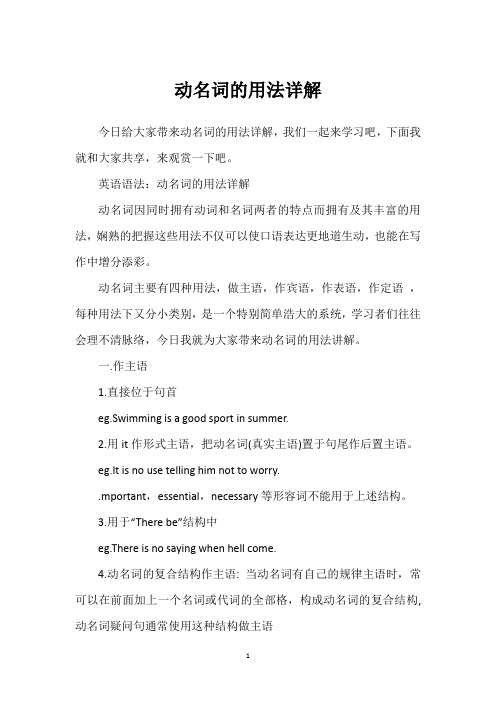
动名词的用法详解今日给大家带来动名词的用法详解,我们一起来学习吧,下面我就和大家共享,来观赏一下吧。
英语语法:动名词的用法详解动名词因同时拥有动词和名词两者的特点而拥有及其丰富的用法,娴熟的把握这些用法不仅可以使口语表达更地道生动,也能在写作中增分添彩。
动名词主要有四种用法,做主语,作宾语,作表语,作定语,每种用法下又分小类别,是一个特别简单浩大的系统,学习者们往往会理不清脉络,今日我就为大家带来动名词的用法讲解。
一.作主语1.直接位于句首eg.Swimming is a good sport in summer.2.用it作形式主语,把动名词(真实主语)置于句尾作后置主语。
eg.It is no use telling him not to worry..mportant,essential,necessary等形容词不能用于上述结构。
3.用于“There be”结构中eg.There is no saying when hell come.4.动名词的复合结构作主语: 当动名词有自己的规律主语时,常可以在前面加上一个名词或代词的全部格,构成动名词的复合结构,动名词疑问句通常使用这种结构做主语eg.Their coming to help was a great encouragement to us.Does your saying that mean anything to him?二.作宾语1.作动词的宾语某些动词后消失非限定性动词时只能用动名词作宾语,不能用不定式。
不定式通常指某种特定的动作,但动名词表示泛指,常见的此类动词有:admit,appreciate,excuse,stand,advise,allow,permit,avoid,consider,enjoy,f inish,give up,cannot help,imagine,include,keep,understand,keepon,mind,report,risk,miss,put off,delay,practise,resist,suggest,depend on,think about,set about,succeed in,worry about,burst out,insist on,feel like,be used to,get used to,devote…to…,look forward to,pay attention to,get down to,escape and so on.eg.They went on walking and never stopped talking.他们连续走,说个不停。
动名词的构成与用法详细解析
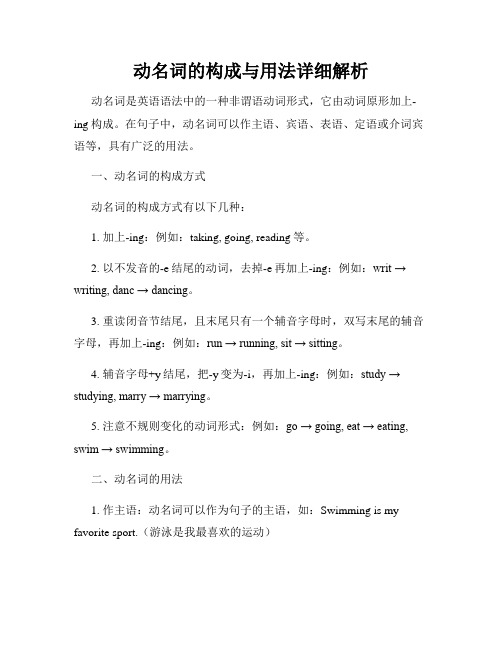
动名词的构成与用法详细解析动名词是英语语法中的一种非谓语动词形式,它由动词原形加上-ing构成。
在句子中,动名词可以作主语、宾语、表语、定语或介词宾语等,具有广泛的用法。
一、动名词的构成方式动名词的构成方式有以下几种:1. 加上-ing:例如:taking, going, reading等。
2. 以不发音的-e结尾的动词,去掉-e再加上-ing:例如:writ → writing, danc → dancing。
3. 重读闭音节结尾,且末尾只有一个辅音字母时,双写末尾的辅音字母,再加上-ing:例如:run → running, sit → sitting。
4. 辅音字母+y结尾,把-y变为-i,再加上-ing:例如:study → studying, marry → marrying。
5. 注意不规则变化的动词形式:例如:go → going, eat → eating, swim → swimming。
二、动名词的用法1. 作主语:动名词可以作为句子的主语,如:Swimming is my favorite sport.(游泳是我最喜欢的运动)2. 作宾语:动名词可以作为动词的宾语,如:I enjoy reading books.(我喜欢读书)3. 作表语:动名词可以作为系动词的表语,如:Her favorite hobby is dancing.(她最喜欢的爱好是跳舞)4. 作定语:动名词可以作为名词的定语,如:I saw a running boy.(我看到一个跑步的男孩)5. 作介词宾语:动名词可以作为介词的宾语,如:He's interested in learning English.(他对学习英语很感兴趣)6. 与情态动词连用:动名词可以与情态动词连用,表示推测、意图或能力,如:He must be sleeping.(他一定在睡觉)7. 在某些固定短语中使用:动名词在一些固定短语中使用,如:look forward to, be worth, give up等。
动名词的用法及常见搭配解析
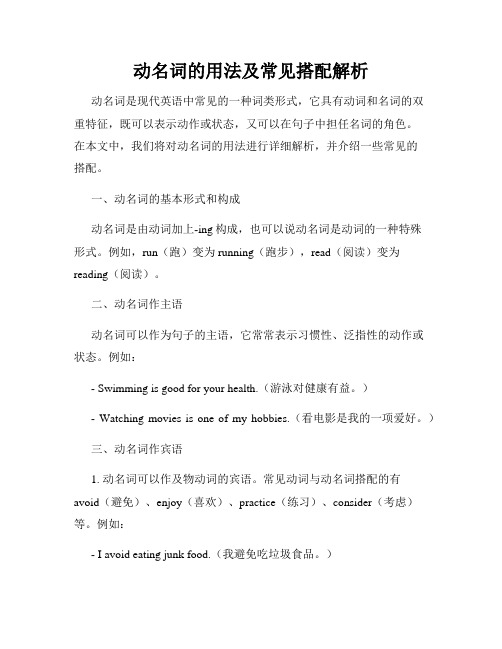
动名词的用法及常见搭配解析动名词是现代英语中常见的一种词类形式,它具有动词和名词的双重特征,既可以表示动作或状态,又可以在句子中担任名词的角色。
在本文中,我们将对动名词的用法进行详细解析,并介绍一些常见的搭配。
一、动名词的基本形式和构成动名词是由动词加上-ing构成,也可以说动名词是动词的一种特殊形式。
例如,run(跑)变为running(跑步),read(阅读)变为reading(阅读)。
二、动名词作主语动名词可以作为句子的主语,它常常表示习惯性、泛指性的动作或状态。
例如:- Swimming is good for your health.(游泳对健康有益。
)- Watching movies is one of my hobbies.(看电影是我的一项爱好。
)三、动名词作宾语1. 动名词可以作及物动词的宾语。
常见动词与动名词搭配的有avoid(避免)、enjoy(喜欢)、practice(练习)、consider(考虑)等。
例如:- I avoid eating junk food.(我避免吃垃圾食品。
)- He enjoys playing basketball.(他喜欢打篮球。
)2. 动名词可以作介词的宾语。
常见介词与动名词搭配的有think about(思考)、look forward to(期待)、worry about(担心)等。
例如:- I'm thinking about changing my job.(我正在考虑换工作。
)- She is looking forward to visiting Paris.(她期待着去巴黎旅行。
)四、动名词作补语动名词还可以作及物动词的宾语补足语,表示完成或结果。
常见动词与动名词搭配的有find(发现)、keep(保持)、leave(离开)等。
例如:- I found her crying in the room.(我发现她在房间里哭泣。
英语中的动名词解释
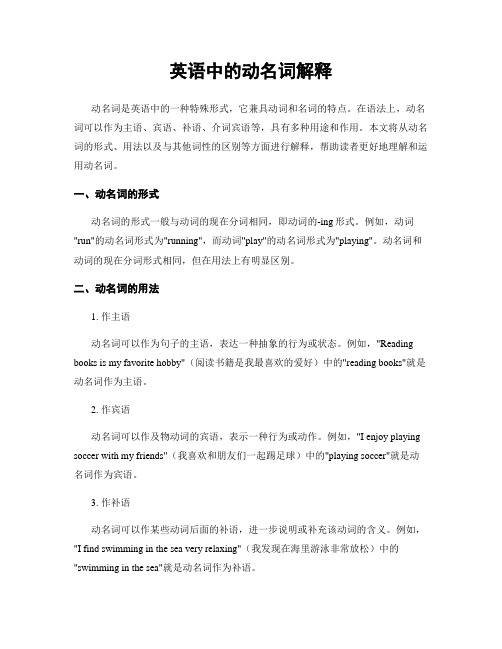
英语中的动名词解释动名词是英语中的一种特殊形式,它兼具动词和名词的特点。
在语法上,动名词可以作为主语、宾语、补语、介词宾语等,具有多种用途和作用。
本文将从动名词的形式、用法以及与其他词性的区别等方面进行解释,帮助读者更好地理解和运用动名词。
一、动名词的形式动名词的形式一般与动词的现在分词相同,即动词的-ing形式。
例如,动词"run"的动名词形式为"running",而动词"play"的动名词形式为"playing"。
动名词和动词的现在分词形式相同,但在用法上有明显区别。
二、动名词的用法1. 作主语动名词可以作为句子的主语,表达一种抽象的行为或状态。
例如,"Reading books is my favorite hobby"(阅读书籍是我最喜欢的爱好)中的"reading books"就是动名词作为主语。
2. 作宾语动名词可以作及物动词的宾语,表示一种行为或动作。
例如,"I enjoy playing soccer with my friends"(我喜欢和朋友们一起踢足球)中的"playing soccer"就是动名词作为宾语。
3. 作补语动名词可以作某些动词后面的补语,进一步说明或补充该动词的含义。
例如,"I find swimming in the sea very relaxing"(我发现在海里游泳非常放松)中的"swimming in the sea"就是动名词作为补语。
4. 作介词宾语有些介词后面需要使用动名词作为宾语。
例如,"I am interested in learning new languages"(我对学习新语言感兴趣)中的"learning new languages"就是动名词作为介词"in"的宾语。
动名词初中动名词的构成和用法解析
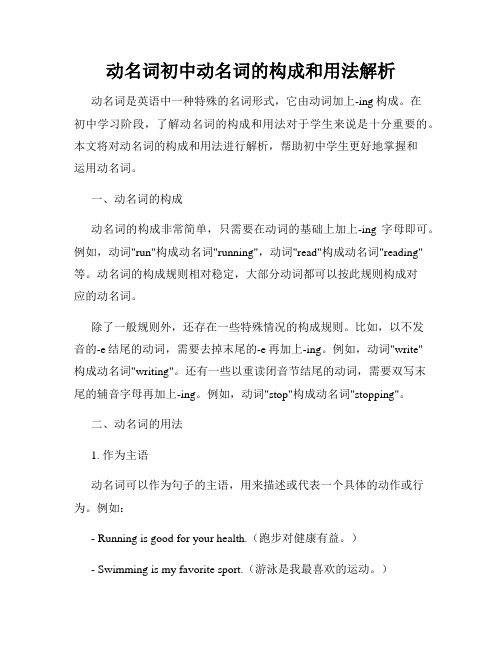
动名词初中动名词的构成和用法解析动名词是英语中一种特殊的名词形式,它由动词加上-ing构成。
在初中学习阶段,了解动名词的构成和用法对于学生来说是十分重要的。
本文将对动名词的构成和用法进行解析,帮助初中学生更好地掌握和运用动名词。
一、动名词的构成动名词的构成非常简单,只需要在动词的基础上加上-ing字母即可。
例如,动词"run"构成动名词"running",动词"read"构成动名词"reading"等。
动名词的构成规则相对稳定,大部分动词都可以按此规则构成对应的动名词。
除了一般规则外,还存在一些特殊情况的构成规则。
比如,以不发音的-e结尾的动词,需要去掉末尾的-e再加上-ing。
例如,动词"write"构成动名词"writing"。
还有一些以重读闭音节结尾的动词,需要双写末尾的辅音字母再加上-ing。
例如,动词"stop"构成动名词"stopping"。
二、动名词的用法1. 作为主语动名词可以作为句子的主语,用来描述或代表一个具体的动作或行为。
例如:- Running is good for your health.(跑步对健康有益。
)- Swimming is my favorite sport.(游泳是我最喜欢的运动。
)2. 作为宾语动名词可以作为及物动词的宾语,表示动作的承受者。
例如:- I enjoy reading books.(我喜欢读书。
)- She hates doing chores.(她讨厌做家务。
)3. 作为介词的宾语动名词可以作为介词的宾语,与介词共同构成介词短语。
例如:- He is good at playing the guitar.(他擅长弹吉他。
)- They are interested in learning new things.(他们对学习新事物感兴趣。
- 1、下载文档前请自行甄别文档内容的完整性,平台不提供额外的编辑、内容补充、找答案等附加服务。
- 2、"仅部分预览"的文档,不可在线预览部分如存在完整性等问题,可反馈申请退款(可完整预览的文档不适用该条件!)。
- 3、如文档侵犯您的权益,请联系客服反馈,我们会尽快为您处理(人工客服工作时间:9:00-18:30)。
动名词是一种兼有动词和名词特征的非谓语动词。
它可以支配宾语,也能被副词修饰。
动名词有时态和语态的变化。
解释:动词的ing形式如果是名词,这个词称动名词。
特征:动词原形+ing构成,具有名词,动词一些特征一、动名词的作用动名词具有名词的性质,因此在句中可以作主语、表语、宾语、定语等。
1、作主语Reading is an art. 读书是一种艺术。
Climbing mountains is really fun. 爬山是真有趣。
Working in these conditions is not a pleasure but a suffer. 在这种工作条件下工作不是愉快而是痛苦。
动名词作主语,有时先用it作形式主语,把动名词置于句末。
这种用法在习惯句型中常用。
如:It is no use/no good crying over spilt milk. 洒掉的牛奶哭也没用。
It is a waste of time persuading such a person to join us. 劝说这样的人加入真是浪费时间。
It was hard getting on the crowded street car. 上这种拥挤的车真难。
It is fun playing with children. 和孩子们一起玩真好。
There is no joking about such matters. 对这种事情不是开玩笑。
动名词作主语的几种类型动名词可以在句子中充当名词所能充当的多种句子成分。
在这里仅就动名词在句子中作主语的情况进行讨论。
动名词作主语有如下几种常见情况:1. 直接位于句首做主语。
例如:Swimming is a good sport in summer.2. 用it 作形式主语,把动名词(真实主语)置于句尾作后置主语。
动名词做主语时,不太常用it 作先行主语,多见于某些形容词及名词之后。
例如:It is no use telling him not to worry.常见的能用于这种结构的形容词还有:better,wonderful,enjoyable,interesti ng,foolish,difficult,useless,senseless,worthwhile,等。
注意:important,essential,necessary 等形容词不能用于上述结构。
3. 用于“There be”结构中。
例如:There is no saying when he'll come.很难说他何时回来。
4. 用于布告形式的省略结构中。
例如:No smoking ( =No smoking is allowed (here) ). (禁止吸烟)No parking. (禁止停车)5. 动名词的复合结构作主语当动名词有自己的逻辑主语时,常可以在前面加上一个名词或代词的所有格,构成动名词的复合结构(——这时,名词或代词的所有格做动名词的逻辑主语)。
动名词的复合结构也可以在句中作主语。
例如:Their coming to help was a great encouragement to us.6.例词shopping fishing cycling这些都是很常见的动名词二、动名词作主语与动词不定式作主语的比较动词不定式和动名词都可以用作主语。
在意义上相近。
但动名词多用来表示泛指或抽象动作,不定式多用来表示特指或具体动作。
比较:Smoking is not good for health.It is not good for you to smoke so much.注意:1)在口语中,用动名词作主语位于句首的较不定式多见。
2)在“It is no use...”,“It is no good...”,“It is fun...”,“It is a waste of time...”等句型中,通常用动名词作真实主语:It is no use/good/a waste of time talking about that.*It is no use/good/a waste of time to talk about that.3)在疑问句中,通常用动名词的复合结构,而不用不定式的复合结构作主语:Does your saying that mean anything to him?*Does for you to say that mean anything to him?4)在“There be”句型中,只能用动名词,而不能用不定式作主语:There is no telling what will happen.It is impossible to tell what will happen.5)当句子中的主语和表语都是非限定动词时,要遵循前后一致的原则,主语和表语在形式上要求统一:Seeing is believing.*To see is to believe.2、作宾语(1)作动词的宾语某些动词后出现非谓语动词时只能用动名词作宾语,不能用不定式。
常见的此类动词有:advise, allow, permit, avoid, consider, enjoy, finish, give up, cannot help, imagine, include, keep, keep on, mind, miss, put off, delay, practise, r esist, suggest, depend on, think about, set about, succeed in, worry about, burst out, insis t on, can’t stand, be used to, get used to, devote…to…, look forward to, pay attention to, get down to,escape 等。
如:They went on walking and never stopped talking.他们继续走,说个不停。
I found it pleasant walking along the seashore.在海滩上走真是乐事。
Mark often attempts to escape being fined whenever he breaks traffic re gulations.每当马克违反交通规则时,他常常企图逃避罚款的处分。
(2)作介词的宾语We are thinking of making a new plan for the next term. 我们正考虑为下学期制定新的计划。
Shall we have a rest or get down to doing our work? 我们休息呢还是开始干活?(3)作形容词的宾语The music is well worth listening to more than once. 这种曲子很值得多听几遍。
We are busy preparing for the coming sports meet. 我们正为马上到来的运动会忙着做准备。
3、作表语动名词作表语时句子主语常是表示无生命的事物的名词或what引导的名词性从句。
表语动名词与主语通常是对等的关系,表示主语的内容,主语、表语可互换位置。
Your task is cleaning the windows. 你的任务就是擦窗户。
(Cleaning the wi ndows is your task.)What I hate most is being laughed at. 我最痛恨的就是被别人嘲笑。
(Being laughed at is what I hate most.)4、作定语动名词作定语往往表示被修饰词的某种用途。
如:a walking stick =a stick for walking=a stick which is used for walkinga washing machine=a machine for washing=a machine which is used for washinga reading room=a room for reading=a room which is used for readinga measuring tape=a tape for measuring=a tape which is used for measu ringsleeping pills=pills for sleeping=pills which is used for sleeping。
二、动名词的逻辑主语带有逻辑主语的动名词称为动名词的复合结构。
当动名词的逻辑主语与句子的主语不一致时,要在动名词之前加上物主代词或名词所有格,这便构成了动名词的复合结构。
其中物主代词(名词所有格)是逻辑上的主语,动名词是逻辑上的谓语。
动名词复合结构在句中可作主语、宾语、表语等,分别相当于一个主语从句、宾语从句、表语从句。
如:Her coming to help encouraged all of us. 他来帮忙鼓舞了我们所有人。
(= That she came to help encouraged all of us.)Jane’s being careless caused so much trouble. 简的粗心惹来了不少麻烦。
(=That Jane was careless caused so much trouble.)What’s troubling them is their not having enough food. 烦扰他们的是食物不足。
(=What’s troublin g them is that they have not enough food.) 在口语中,如果动名词复合结构作宾语,其中的物主代词常用人称代词宾格,名词所有格常用名词普通格来代替,但在句首作主语时不能这样来代替。
如:Would you mind my/me using your computer? 用下你的电脑介意吗?The father insisted on his son’s/his son going to college. 爸爸坚决要求儿子上大学。
Mary’s (不可用Mary) being ill made her mother upset. 玛丽病了,使她妈妈很着急。
His (不可用Him)smoking made his family angry. 他抽烟使他一家人非常生气。
